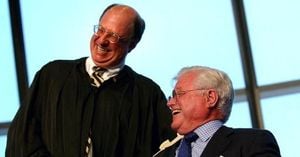On October 4, 2025, the streets of Portland, Oregon, once again became the epicenter of a national debate over the use of federal force during protests, as President Donald Trump announced plans to deploy National Guard troops to the city. The move, justified by the Trump administration as a necessary response to what it described as “violent riots” and “Antifa domestic terrorists” surrounding the Portland ICE facility, was met with immediate resistance from Oregon officials and ignited a flurry of legal and political activity.
According to KPTV, President Trump’s decision followed several weeks of demonstrations outside the Immigration and Customs Enforcement (ICE) facility in South Portland. The administration framed the protests as a threat to federal property and law enforcement, with White House spokesperson Abigail Jackson stating, “President Trump exercised his lawful authority to protect federal assets and personnel in Portland following violent riots and attacks on law enforcement — we expect to be vindicated by a higher court.”
But the president’s announcement was far from universally welcomed. Oregon’s Democratic leadership, including Governor Kotek, Portland Mayor Keith Wilson, and Attorney General Dan Rayfield, swiftly pushed back. The same day as Trump’s announcement, Attorney General Rayfield filed a lawsuit in U.S. District Court seeking to block the deployment of National Guard troops. By late afternoon, a federal judge had granted a temporary restraining order, halting the deployment until at least October 18.
“The court agreed with our position. Today’s ruling is a healthy check on the president,” Rayfield said in a statement provided to KPTV. “It reaffirms what we already knew: Portland is not the president’s war-torn fantasy. Our city is not ravaged, and there is no rebellion. The president must demonstrate an actual threat based on real facts if he wants to put the National Guard on our streets. Members of the Oregon National Guard are not a tool for him to use in his political theater.”
Governor Kotek echoed Rayfield’s sentiments, arguing, “There is no insurrection in Portland. No threat to national security. No fires, no bombs, no fatalities due to civil unrest. The only threat we face is to our democracy — and it is being led by President Donald Trump.”
Portland Mayor Keith Wilson, for his part, praised the city’s response to the protests, stating, “Today’s outcome is proof that Portlanders’ commitment to peaceful expression and civic unity truly matters. We have not met aggression with aggression. We’ve stood firm, calm and grounded in our shared values and that is why this decision went our way. Portland has shown that peace is power.”
Senator Ron Wyden also weighed in, calling the court’s decision a “victory” and criticizing the proposed deployment as “provoking conflict” and wasting taxpayer dollars. “Today’s victory clearly supports what Oregonians already know: we don’t need or want Donald Trump to provoke conflict by deploying federal troops in our state. I will keep working with local and state officials to ensure Trump does not keep wasting millions of taxpayer dollars to make Portland the center of his perverse fantasy about conducting assaults on U.S. cities,” Wyden stated, according to KPTV.
Despite the legal victory for Oregon’s leaders, the situation on the ground remained tense. Earlier in the day, protesters had gathered at Elizabeth Caruthers Park before marching to the ICE facility. By mid-afternoon, Portland police reported that officers had not witnessed any property damage or assaults, though protesters were blocking the street, prompting efforts to reopen the roadway for traffic.
However, calm did not last. Tear gas was deployed following a brief standoff between protesters and federal agents, the Associated Press reported. The deployment of tear gas was just one episode in a day marked by heightened tensions and sporadic confrontations.
Behind the scenes, the Portland Police Bureau (PPB) had activated an Incident Command Team to manage the protest activity, as detailed in their public statements. The team, overseen by a Crowd Management Incident Commander, coordinated resources including Dialogue Liaison Officers (DLOs), the Rapid Response Team, the Air Support Unit, and the PPB Sound Truck. The DLOs, easily identifiable by their white uniform shirts, acted as liaisons to demonstrators and were not involved in enforcement, reflecting the PPB’s stated policy of supporting constitutionally protected activity while maintaining public safety.
At about 8:15 p.m., police observed demonstrators encroaching into the street, causing neighborhood traffic to swerve or stop. Most protesters complied with requests from DLOs and announcements from the Sound Truck to move to the sidewalk, but two individuals refused and were observed acting aggressively toward each other, both using sound amplification devices. Officers from the Rapid Response Team moved in and arrested Thomas Wayne Allen, 36, and Cortez Carl Williams, 34, both of Portland. Allen was found with a can of chemical spray and a collapsible metal coil baton. Both were booked on charges of Disorderly Conduct in the Second Degree, according to the PPB and KPTV.
Police noted that their presence, targeted arrests, and clear communication helped suppress physical fights during the protest. “There were individuals who gathered to confront one another and passionately debate their opposing points of view. However, the police presence, targeted arrests, and announcements from the PPB Sound Truck were effective in suppressing any physical fights breaking out,” the PPB stated in a public update.
In total, five protesters were arrested outside the ICE facility between October 3 and 4, including a prominent conservative influencer, as reported by KPTV. The PPB emphasized that while their primary role is public safety and supporting constitutionally protected activity, they will continue to monitor protests, address criminal acts, and forward cases to the Multnomah County District Attorney for prosecution when feasible.
As the legal and political battle over federal intervention played out, Portland’s streets remained a stage for civic activism, debate, and, at times, confrontation. The city’s leaders and law enforcement walked a fine line between supporting the right to protest and maintaining order, even as national attention—and presidential rhetoric—focused on their every move. The temporary restraining order may have paused the deployment of federal troops, but the underlying tensions and questions about the balance between security and civil liberties remain as pressing as ever.
In Portland, the events of October 4 underscored a broader struggle over the role of federal power, the meaning of public safety, and the enduring importance of local voices in shaping the city’s future.




